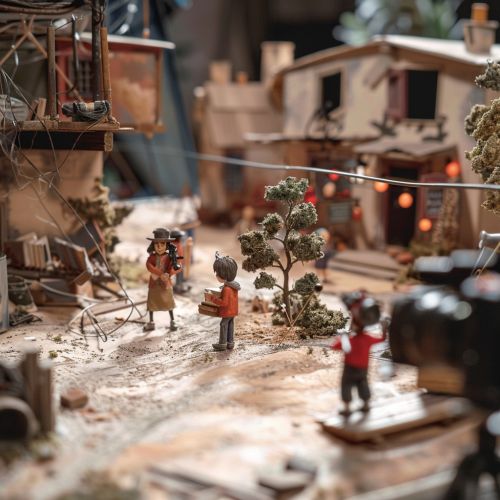Stop-motion Animation: Difference between revisions
(Created page with "== Overview == Stop-motion animation is a cinematic technique that physically manipulates objects so they appear to move on their own. The objects are moved in small increments between individually photographed frames, creating the illusion of movement when the series of frames is played as a continuous sequence. This technique makes a physically manipulated object appear to move on its own. The object is moved in small amounts between individually photographed frames, c...") |
No edit summary |
||
| Line 2: | Line 2: | ||
Stop-motion animation is a cinematic technique that physically manipulates objects so they appear to move on their own. The objects are moved in small increments between individually photographed frames, creating the illusion of movement when the series of frames is played as a continuous sequence. This technique makes a physically manipulated object appear to move on its own. The object is moved in small amounts between individually photographed frames, creating the illusion of movement when the series of frames is played as a sequence. | Stop-motion animation is a cinematic technique that physically manipulates objects so they appear to move on their own. The objects are moved in small increments between individually photographed frames, creating the illusion of movement when the series of frames is played as a continuous sequence. This technique makes a physically manipulated object appear to move on its own. The object is moved in small amounts between individually photographed frames, creating the illusion of movement when the series of frames is played as a sequence. | ||
[[Image:Detail-79029.jpg|thumb|center|A detailed and close-up shot of a stop-motion animation setup. The scene should depict a miniature set with characters and props, all ready for the next frame to be shot.]] | |||
== History == | == History == | ||
Revision as of 15:25, 16 May 2024
Overview
Stop-motion animation is a cinematic technique that physically manipulates objects so they appear to move on their own. The objects are moved in small increments between individually photographed frames, creating the illusion of movement when the series of frames is played as a continuous sequence. This technique makes a physically manipulated object appear to move on its own. The object is moved in small amounts between individually photographed frames, creating the illusion of movement when the series of frames is played as a sequence.

History
The first instance of stop-motion animation can be traced back to the late 19th century. Pioneers like James Stuart Blackton and Albert Edward Smith introduced the basic concepts of stop-motion in their work. The technique was further developed and popularized by filmmakers such as Willis H. O'Brien and Raymond Frederick Harryhausen in the 20th century.
Techniques
There are several different techniques used in stop-motion animation, each with its own unique aesthetic and technical characteristics. These include:
Puppet Animation
Puppet animation is a form of stop-motion animation that involves the manipulation of three-dimensional puppets and other objects. The puppets generally have an internal armature that allows for more controlled movement. This technique is often used in feature films and television series.
Clay Animation
Clay animation, or claymation, is a type of stop-motion animation that uses figures made of clay or a similar malleable material. The flexibility of the material allows for easy repositioning of the characters between frames.
Cut-out Animation
Cut-out animation is a technique where two-dimensional characters and backgrounds are cut out of materials such as paper or cloth and manipulated frame by frame. This technique is often used for its stylistic simplicity and low production cost.
Pixilation
Pixilation is a type of stop-motion animation that uses live actors as the animated objects. The actors are posed and then photographed frame by frame, creating a surreal effect when the sequence is played back.
Production Process
The production process of stop-motion animation can be divided into several stages, including pre-production, production, and post-production.
Pre-production
The pre-production stage involves the development of the script, storyboard, character design, and set design. This stage is crucial for planning the animation and ensuring a smooth production process.
Production
The production stage involves the actual shooting of the animation. This is a time-consuming process as each frame needs to be set up and photographed individually. Depending on the complexity of the animation, this stage can take weeks, months, or even years to complete.
Post-production
The post-production stage involves the editing of the photographed frames into a continuous sequence. This stage also includes the addition of sound effects, music, and voice-over.
Applications
Stop-motion animation has a wide range of applications, from feature films and television series to music videos and advertisements. It is also used in education to teach concepts in a visual and engaging way.
Challenges
Despite its unique aesthetic and creative possibilities, stop-motion animation presents several challenges. These include the time-consuming nature of the production process, the difficulty of making changes once the shooting has started, and the technical skills required to create smooth and believable movement.
Future
With advancements in technology, the future of stop-motion animation looks promising. Digital cameras and software have made the production process more efficient, while the internet has provided a platform for independent animators to showcase their work. Despite the rise of computer-generated animation, stop-motion continues to be a popular and respected form of animation.
